The following mint errors are featured in the upcoming April 30 - May 4, 2025 CSNS US Coins Signature® Auction #1383.

Images Courtesy of Heritage Auctions, HA.com
1943 Bronze Cent, AU55
Exceptional CAC-Approved Example
Legendary Wrong Planchet Mint Error



1943 1C Struck on a Bronze Planchet AU55 PCGS. CAC. The 1943 bronze cent is a mint error whose popularity transcends the Lincoln cent series, and indeed, numismatic circles entirely. The birth of its popularity began in 1947. Two examples of the error were discovered that year, one by 16-year-old Don Lutes, Jr., who received one in change from his high school cafeteria, and another by the son of Conrad Ottelin, M.D., who found one in his mother's coin bank. Lutes did not immediately report his find, but instead the coin remained in the family for the next 70 years. It was auction by Heritage in 2019 for $204,000.
The coin found by Ottelin's son was reported in 1947, however. Ottelin wrote to The Numismatist in the June 1947 issue:
"Dear Editor:
"My son heard a rumor that Ford Motor would give a car for a copper cent of 1943 (none of which was supposed to have been minted) so he looked through mother's bank and found one. He wrote the Ford Company and the reply was that it was only a 'rumor.' He showed the coin to two collectors and we all decided that is was copper and not zinc coated steel.
"I'm wondering if you know whether they actually minted a few copper pieces, though officially only steel [sic] coated cents were made!"
Ottelin's letter to the Editor referenced a rumor that had been circulating at the time, that the Ford Motor Company would give a car to anyone who could produce a genuine 1943 bronze cent. The rumor, as noted in Ottelin's letter, was false, but it fueled much speculation and searching in the general public. Thus, from the beginning, the appeal of the 1943 bronze cent exceeded the boundaries of traditional numismatic interest, drawing on the desires of the general public. Even today, that trans-numismatic appeal remains in place, with mainstream media promoting this coin as the find of a lifetime to non-collectors of the public. And as a result, many hopeful individuals contact dealers and numismatic acquaintances regarding the authentication of what they believe to be one of these rare bronze errors, only to be disheartened when they learn the coin they have is copper-plated steel, or is another form of fake. Indeed, today, the 1943 bronze cent, due to its widespread and enduring popularity with the public, is one of the most sought-after and one of the most often faked rare coins in U.S. numismatics.
The genuine 1943 bronze cents were apparently struck by accident. Pieces were made by all three active mints, but mostly at Philadelphia. In 1943, the cent's alloy was changed from bronze to zinc-coated steel to preserve copper for the war effort. However, by 1947, with the discovery of bronze 1943 cents in circulation, speculation began concerning how such coins could have been struck. The Mint denied any possibility of error in its coinage up to the 1960s, but eventually conceded that some bronze 1943 cents could have been struck by mistake. The generally accepted theory for their creation is that a few leftover bronze planchets from 1942 remained in Mint machinery or hoppers when the new steel planchets were introduced, and the coins were simply struck in a natural fashion and released without notice. The same circumstances reoccurred in 1944, when leftover steel planchets of 1943 were struck, creating the 1943 bronze cent's "little cousin," the 1944 steel cent.
This is a Choice AU, CAC-approved example of the beloved 1943 bronze cent rarity, a coin that ranks 8th or 9th finest out of perhaps 20 known examples. It appeared twice at auction a little more than a decade ago, but has since been housed in the Sherman Collection. The coin is defined by its uniform, pleasing chestnut-brown patina and satiny surfaces, which retain subtle luster in the fields. The O in ONE exhibits typical softness, but the strike is otherwise bold. A loupe reveals scattered, faint flecks on each side that mostly blend into the patina -- flecks that have long served as pedigree markers for this upper-end example of the bronze rarity. Even ignoring the CAC label, the quality of this piece is immediately apparent when the coin is held in-hand. Collectors have been searching for a bronze 1943 cent for many decades. This piece will mark the conclusion of one lucky bidder's search. Listed among the 100 Greatest U.S. Coins.
Ex: Americana Sale (Stack's Bowers, 1/2013), lot 13257, brought $317,250; Regency Auction VII (Legend-Morphy, 5/2014), lot 12, realized $329,000; Bruce S. Sherman Collection. Certification #26441689. Pictured on PCGS CoinFacts.




1973-S Half Dollar, PR67
Obverse Struck-In Copper Planchet
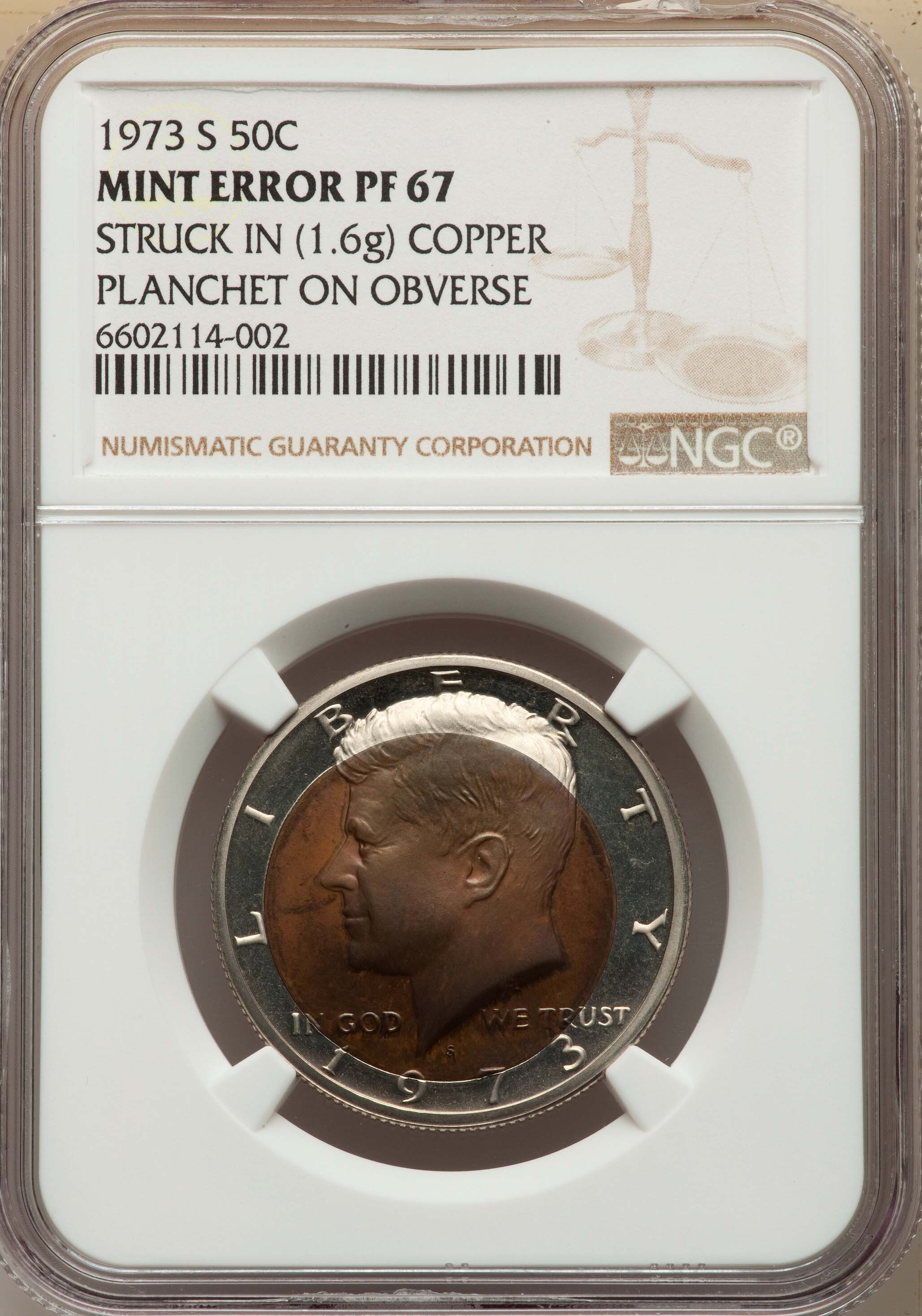


1973-S Kennedy Half Dollar -- Struck-in Copper Planchet on Obverse -- PR67 NGC. 1.6 grams. A copper disc, of non-standard weight for U.S. coinage, is struck into the obverse of this proof 1973-S half dollar. The reverse has a normal appearance. The copper disc has attractively toned in ocean-blue, peach-gold, sea-green, and plum-red hues. The remainder of the coin has a clad alloy and remains brilliant. The copper disc is moderately off center within the obverse, favoring the southwest.
Ex: Misfits Collection of U.S. Error Coinage (Heritage, 12/2022), lot 93217.




1972-S Eisenhower Dollar, PR65
Struck on Cent and Dime Planchets
Mated Pair Error
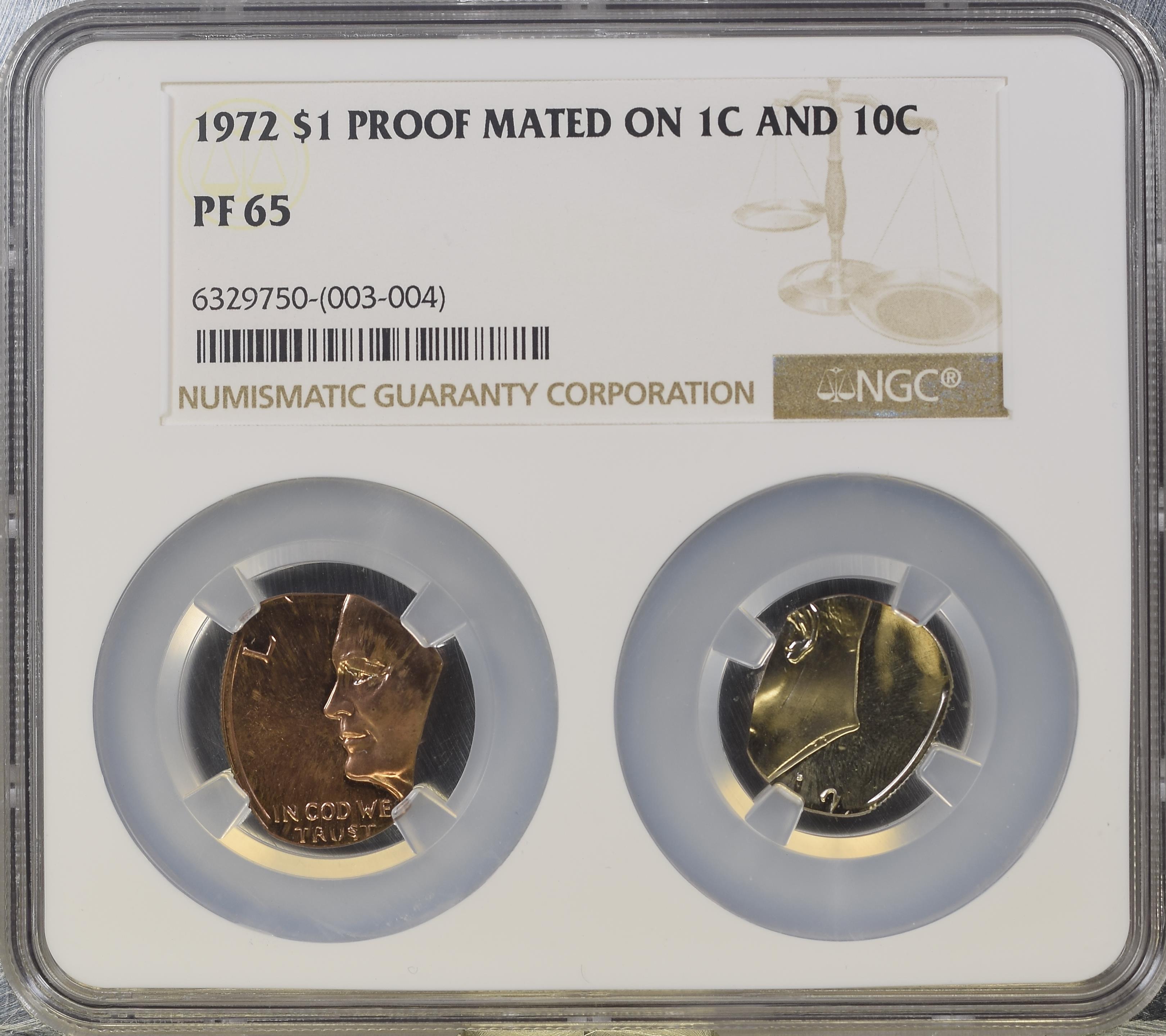

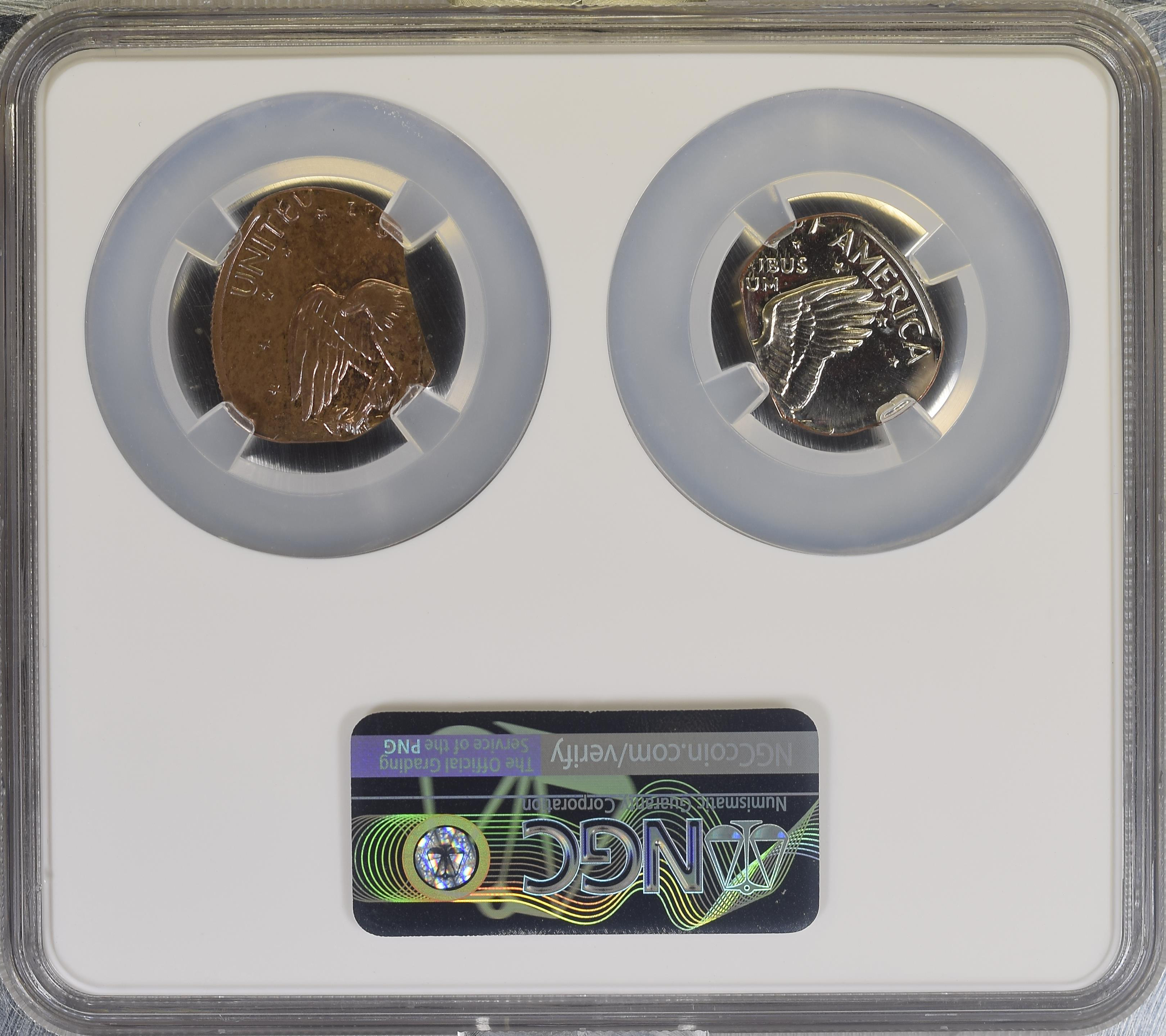
1972-S Eisenhower Dollar -- Mated Pair, Struck on Cent and Dime Planchets -- PR65 NGC. Type Two Reverse. Adjacent cent and dime planchets were simultaneously struck by proof Eisenhower dollar dies. Constrained on the left and right sides by either the dollar die or the other coin, the coins expanded on the upper and lower sides, making both pieces more oval than round. In particular, TRUST and the ED in UNITED have a stretched appearance from metal flow during the strike. The cent obverse is mostly fire-red, while the reverse is primarily toned lavender, gunmetal, and apple-green. The NGC insert does not indicate a San Francisco striking, but the mintmark is present on the obverse of the dollar-on-dime-planchet piece, northwest of the 2 in the date. The remainder of the date is absent from the mated pair. The NGC insert implies that the proof Ike dollar was struck on a struck cent and dime, but there is no indication of an undertype on either coin.


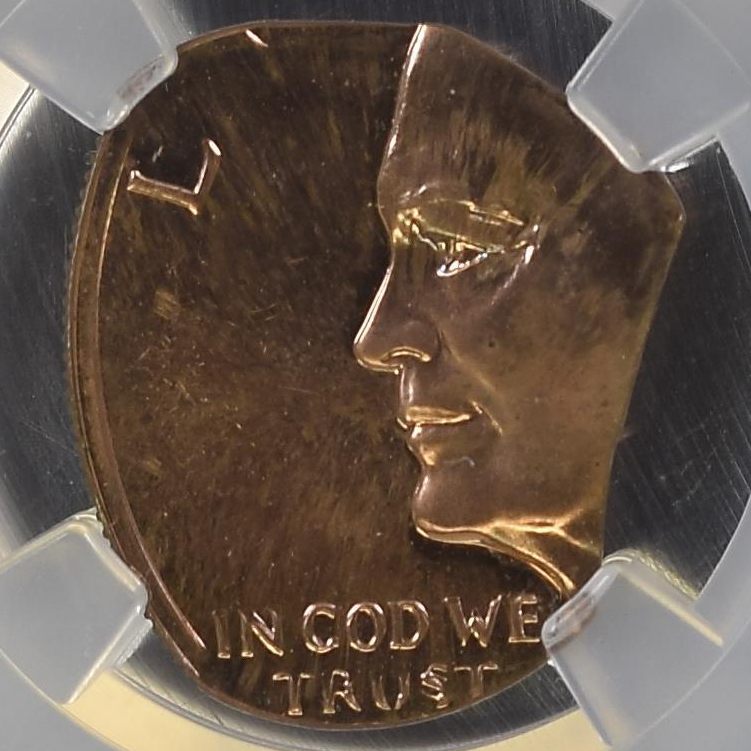
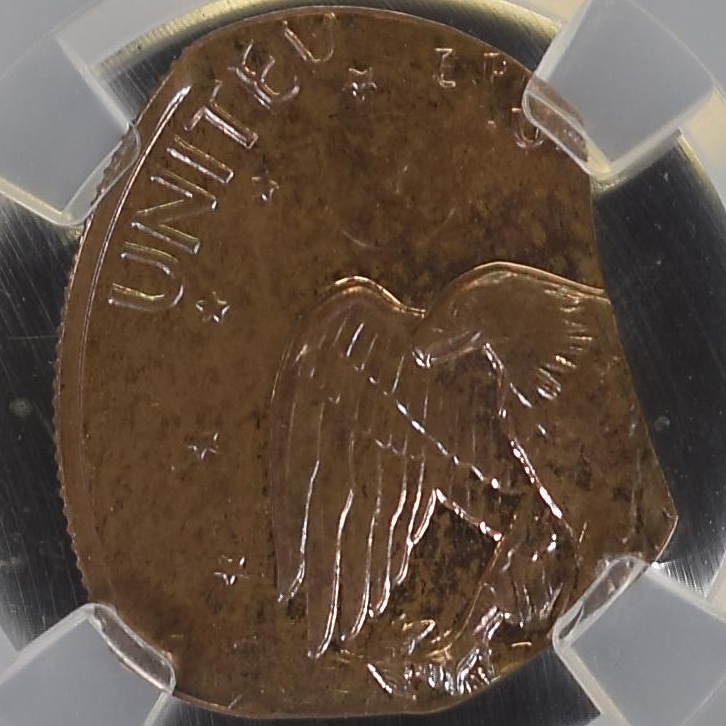
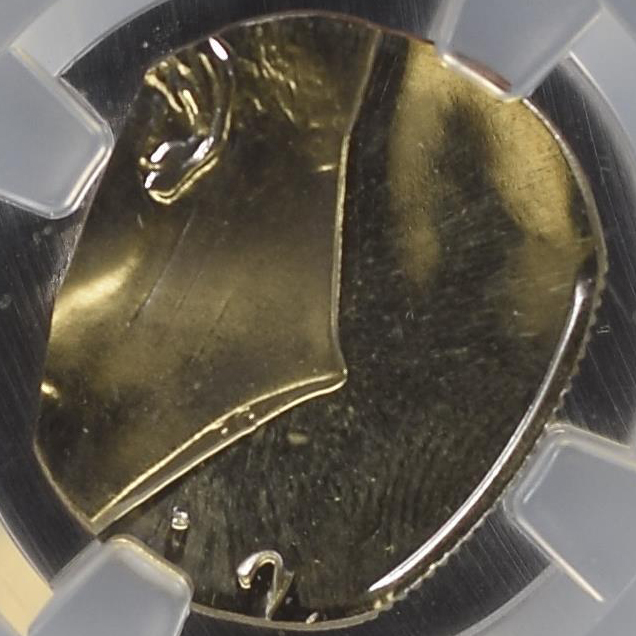
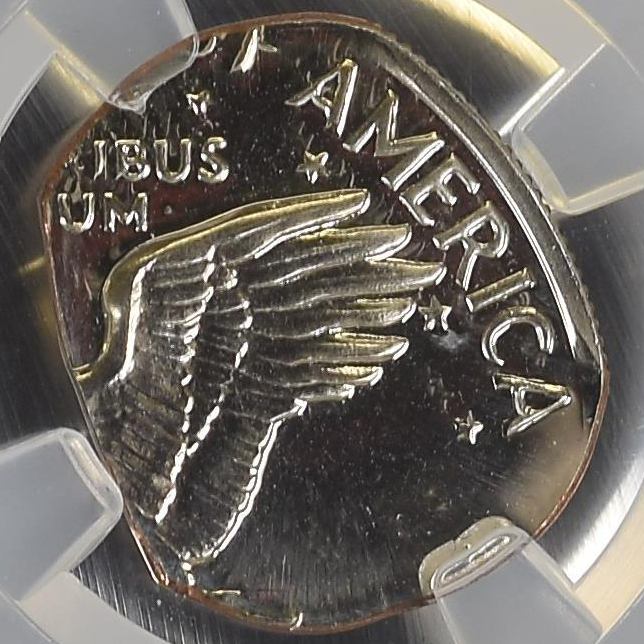
1973-S Ike Dollar, PR65
Struck on Three Dime Planchets



1973-S Eisenhower Dollar -- Struck on Three Clad Dime Planchets -- PR65 PCGS. A spectacular mint error certain to command attention in any display. Three clad planchets intended for proof Roosevelt dime dies were instead simultaneously struck by a single pair of proof Ike dollar dies. The three planchets touched, but did not overlap. They formed a “clover leaf” pattern that consisted of an upper left planchet, an upper right planchet, and a lower planchet centered beneath the upper two planchets. The San Francisco mintmark is present on the lower piece, as is the right portion of IN GOD WE TRUST. The date is complete on the lower piece with the exception of the lower half of the 1. Ike’s profile is complete on the upper left coin, aside from the bottom of the chin. E PLURIBUS UNUM is complete on the reverse of the lower piece. The eagle is evenly divided between the three coins with the head and and left (facing) wing on the upper left piece, the tail on the upper right piece, and the right (facing) wing mostly on the lower piece. ONE DOLLAR, UNITED STATES OF AMERICA, and the planet Earth are incompletely divided across two of the three pieces.





